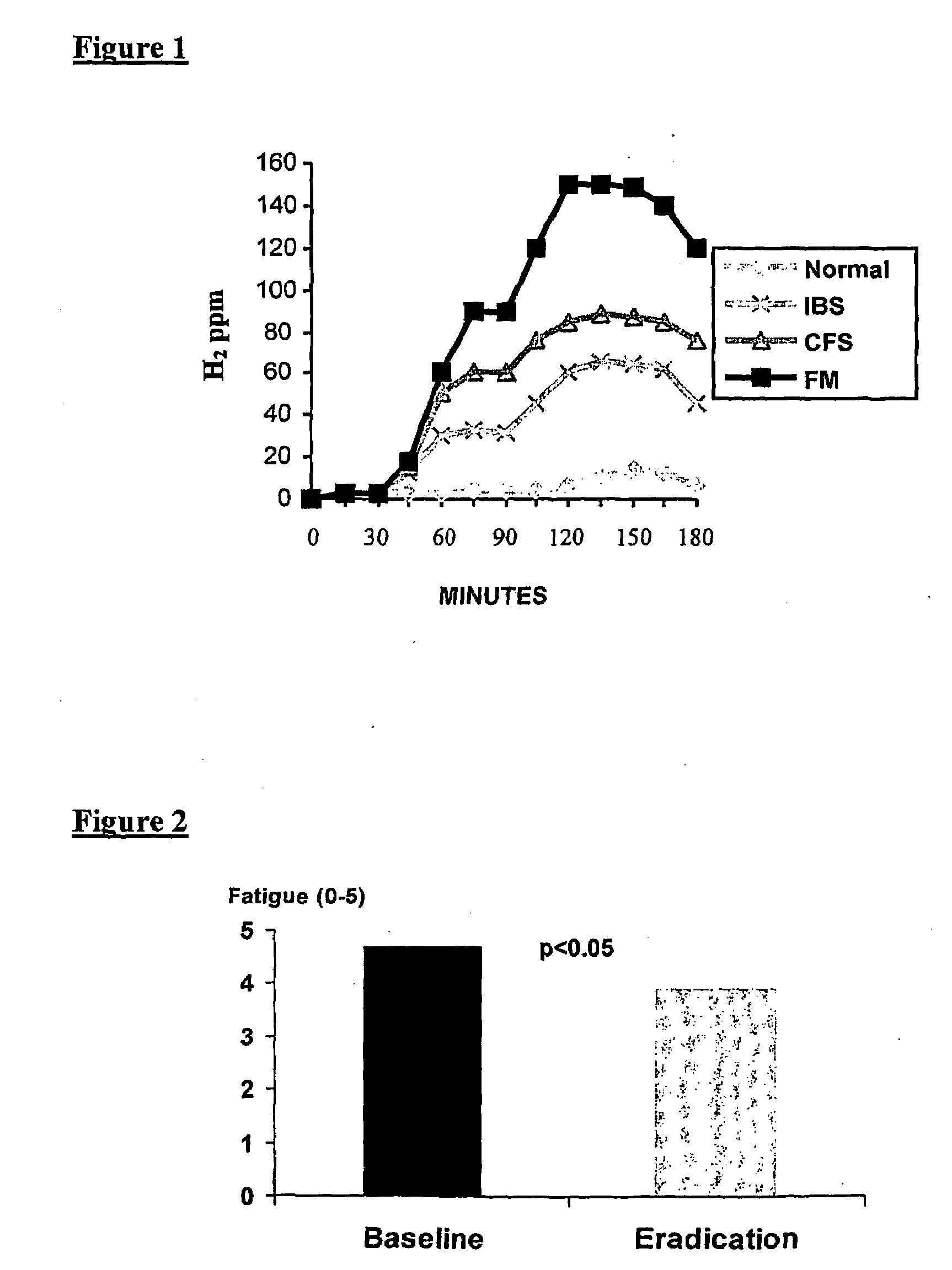Treatment of disease conditions through modulation of hydrogen sulfide produced by small intestinal bacterial overgrowth
a technology of bacterial overgrowth and disease, applied in biocide, biochemistry apparatus and processes, instruments, etc., can solve the problems of cyanide toxicity, respiratory arrest, loss of consciousness and death, etc., and achieve the effect of reducing and lowering the level of h2s
- Summary
- Abstract
- Description
- Claims
- Application Information
AI Technical Summary
Benefits of technology
Problems solved by technology
Method used
Image
Examples
example 1
Chronic Fatigue Syndrome
[0077]In a study investigating the role of SIBO in CFS, 31 patients meeting the U.S. Centers for Disease Control and Prevention criteria for CFS were given a lactulose breath test (LBT). Seventeen of these CFS subjects agreed to open label antibiotic treatment with various antibiotics, including doxycycline. 14 out of 17 had successful eradication of SIBO. CFS symptoms were evaluated 7 days after the 10-day course of antibiotics.
[0078]FIG. 1 shows the average breath hydrogen (H2) profile during the LBT in CFS patients as compared to normal subjects and patients with IBS or fibromyalgia (FM). CFS patients had a peak H2 concentration [H2] of 85 ppm. No measurements were made of methane or H2S in these studies. Symptom score for fatigue was rated on a scale of 0-5. Fatigue was significantly improved by eradication of SIBO (p<0.05) (FIG. 2). Bloating and gas also improved with eradication. In addition, as shown in Table 1, significant improvement was seen in the ...
example 2
Diseases and Conditions Associated with Cognitive Impairment
[0083]As the aged population has increased, the number of elderly people with varying stages of cognitive impairment has also increased. The impairment varies from Alzheimer's disease (AD) where orientation can be severely disturbed, to those with mild loss of memory. Mild cognitive impairment (MCI) and age-associated memory impairment (AAMI) are terms used to describe individuals who suffer from cognitive impairment but are capable of functioning normally in their daily lives. MCI individuals are at increased risk to develop AD. The cause of each of these cognitive impairments was heretofore unknown.
[0084]Reversible MCI has been observed in patients recovering from infection or those with chronic inflammatory diseases raising the possibility that inflammation may be an important cause of cognitive impairment. It has been shown that SIBO is among the explanations, if not the only explanation for IBS (H. C. Lin, Small intest...
example 3
Relationship Among Vascular / Heart Disease and Hyperhomocysteinemia-Induced DNA and Protein Hypomethylation with Therapeutic Lowering of Homocysteine Level
[0089]A 25% reduction of homocysteine level or drop of 3 μM / L is associated with an 11% lowering of the risk of ischemic heart disease and a 19% lowering of the risk of stroke (The Homocysteine Studies Collaboration, Homocysteine and risk of ischmic heart disease and stroke: a meta-analysis, J. Amer. Med. Assoc., 288:2015-22 (2002)). While some have explained this relationship by the effects of homocysteine including increased oxidative stress, enhanced coagulation, decreased fibrinolysis and impaired endothelial biology, another possibility is that elevated homocysteine increases the levels of S-adenosylmethionine (SAM), which is indirectly harmful because it inhibits transmethylation—SAM is a potent inhibitor of transmethylation (C. van Guldener et al., Hyperhomocysteinaemia and vascular disease—a role for DNA hypomethylation, La...
PUM
| Property | Measurement | Unit |
|---|---|---|
| concentration | aaaaa | aaaaa |
| digestible | aaaaa | aaaaa |
| liquid chromatography | aaaaa | aaaaa |
Abstract
Description
Claims
Application Information
 Login to View More
Login to View More - R&D
- Intellectual Property
- Life Sciences
- Materials
- Tech Scout
- Unparalleled Data Quality
- Higher Quality Content
- 60% Fewer Hallucinations
Browse by: Latest US Patents, China's latest patents, Technical Efficacy Thesaurus, Application Domain, Technology Topic, Popular Technical Reports.
© 2025 PatSnap. All rights reserved.Legal|Privacy policy|Modern Slavery Act Transparency Statement|Sitemap|About US| Contact US: help@patsnap.com



